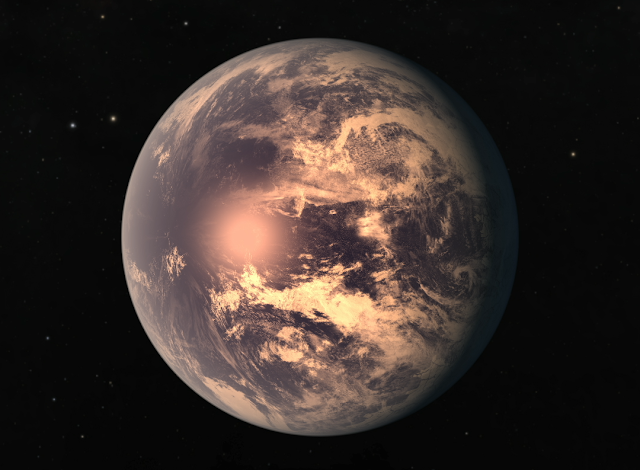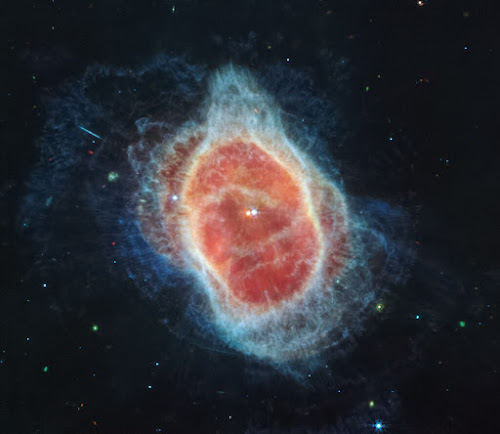 |
| James Webb Telescope |
The highly acclaimed James Webb Telescope just provided NASA with some images of space. These
images are not only stunning, but they also reveal a great deal about the
universe. One of the images shows how the universe appeared 13.1 billion years ago, but another
indicates that water has been discovered on other planets as well.
James Webb telescope:
This telescope cost about $ 10 billion it took NASA 25 years to work out its design and development. The spot where this telescope is located currently is operating at a temperature of -266.75°C. It is so cold that it is almost at the absolute zero temperature of 273°C, the temperature cannot fall beyond that. It is only a few degrees warmer than that. The James Webb space telescope doesn't orbit the planet like the Hubble space telescope does in order to maintain this temperature.
Rather, it orbits around the sun. A point known as the L2 point is 1.5 million kilometres away from Earth and is always in the shadow of the planet, allowing it to safely orbit the sun. A sun screen has been fitted behind it to block out the remaining sunlight. It is very similar in size to a tennis court.The focus length of the James Webb space telescope is more than 2,500 times.131.4 meters. Its main mirror weighs around 705 Kg. This telescope has two infrared cameras placed on it. The near-infrared Camera, NIRCAM, captures the shorter infrared wavelengths. And the Mid Infrared Instrument, MIRICam, Depending on the camera used by the telescope, the photos vary.
 |
| NIRCAM |
 |
| MIRICAM |
|
Feature |
Specification |
|
Primary mirror diameter |
6.5 meters (21 feet) |
|
Total collecting area |
25.4
square meters (273 square feet) |
|
Orbit |
Sun-Earth L2 point, 1.5 million kilometers (1 million miles)
from Earth |
|
Launch date |
December
25, 2021 |
|
First images |
July 11, 2022 |
|
Instruments |
Near-Infrared Imager and Slitless Spectrograph (NIRISS), Mid-Infrared Instrument (MIRI), Fine Guidance Sensor (FGS), Near-Infrared Camera (NIRCam), Near-Infrared Spectrograph (NIRSpec), and Near-Infrared Spectrograph (NIRSpec) |
|
Scientific goals |
Study the first galaxies that formed in the early universe,
observe the formation of stars and planets, and study exoplanets |
|
Feature |
Specification |
|
|
There are two stars in this photo, orbiting around each other, the bright star of the two is at the early stages of its life, and the dimmed star is dying. Over the last 4,000 years, this star has been ejecting clouds of gas and dust as it dies. The planetary Nebula is a cloud of gases and dust that is constantly being tossed around by the two stars with which it is circling. similar to how you would combine sugar and water.
Because of the gravitational pull of both stars, this is the shape of the cloud. Only one star can be seen in the NIRCAM image. And you can see the cloud clearly. But in the MIRI Cam photo, the cloud is quite muted, and two stars clearly because of the longer wavelength, can see the center of the dense cloud. Stars also have a life cycle, much to how humans experience childhood, adolescence, adulthood, old age, and death.
When Sun become a Red Giant?
Our Sun is a star as well. About 5 billion years later, our sun will become a red Giant. It will experience the same phases that the stars in this image are going through after transforming into a red Giant. It becomes a planetary Nebula, after which it’ll be a white dwarf, and then the end. Red giants are bigger in size than an average star, When our sun turns into a red Giant, it will swallow the planets of Venus and Mercury, and the Earth will no longer have living conditions.
 |
| Life Cycle of Sun |
The first photo released by NASA is perhaps the most historic photo too. His image provides a peek of the world 13 billion years ago. After seeing this photo, American President Joe Biden said that “it is a new window into the history of the universe”.
In this photo, we can basically see a galaxy cluster SMACS 0723. Due of their strong gravitational pull, the galaxies that are closer to our camera are distorting the light coming from behind them. It creates a magnifying glass of sorts. This phenomenon has been named Gravitational Lensing. We can see things behind it with the aid of it. It took 1205 hours to take this photo. Actually, the telescope had to take several different images, at different wavelengths, and later combine them. The galaxies in it that have redder colours appear to be further away from us.The redder the galaxy, the farther it is.
Stephan’s Quintet:
 |
| Stephan’s Quintet |
For scientists, this is
immensely interesting to see. The scientist wants to know what happens when
galaxies get so close to one another.
 |
| Birth of a Star |
The mountain range kind of
thing has been named as cosmic cliffs by scientists. This is again a Nebula, A nebula
means a bright area formed by clouds of dust and gases. This specific nebula is
named Carina Nebula. At the stage of a stellar Nebula, a star is born.The red
dots in this photo are basically growing infant stars.
Spectrographic data planet WASP -96B
It is an Exoplanet 1,150 light years away from us. A planet outside of our solar system is referred to as an exoplanet. Apart from two cameras, the James Webb telescope is equipped with a NIRISS. NIRISS stands for “Near Infra-red Imager and slitless spectrograph”. A spectrograph is an instrument which measures the intensity of the various wavelengths of light. For 6.5 hours, the NIRISS measured the light coming from this planet.
 |
| Near Infra-red Imager and slitless spectrograph |
The light curve was the measurement's output.The data plotted on this graph, there’s water on this planet, H20. There are also some clouds and haze present.
 |
| Exoplanet WASP-96b (NIRISS Transit light curve) |
How can we tell by measuring light whether a planet has water or not?
Each colour has a distinct wavelength of light. Additionally, the vibrant environment we perceive all around us is a wavelength-induced illusion.
Example:
Why do humans see plants, trees, and leaves as having a green colour?
Because they contain chlorophyll. Chlorophyll is unique because it absorbs red and blue colour wavelengths, and the wavelength which it cannot absorb, that is the green colour, is what we can see. The water in seas appears blue to humans in a similar way. We see water as having a blue hue because of its ability to absorb various red, yellow, and orange wavelengths but not the blue wavelength found in light. The same reasoning can also be used in reverse. Red and blue wavelengths would be blocked in the light on the other side of a leaf if we were to transmit light through it.
The light from the WASP - 96B, was captured by this
telescope, a graph was prepared on the spectrograph, and the blocked
wavelengths of light were analyzed. Scientists know the exact ratio of blockage
of wavelengths to know which molecule the light had to pass through, it was evidence
of the presence of H20.But this planet is not habitable. Scientists have
discovered other facts about the planet, First of all, the closeness of the
planet to its star, and the size of the planet with those parameters, they have
estimated that the temperature on that planet is more than 530°C.
_mres.png) |
| WASP - 96B |
Theoretical Calculations:
According to the theoretical calculations, it has been estimated that in our Milky Way, in our galaxy, there are about 300 million potential habitable planets. Planets where humans can survive and where life can be found. But practically, with what we have seen and observed in the Milky Way, we have analyzed only 5,000 Exoplanets, although several of them are potentially habitable.
What is TRAPPIST-1E - 1E?
 |
| TRAPPIST-1E - 1E |
In November 2019, researchers found that of all the Exoplanets observed by now, one of those planets has the highest chance of being a habitable planet, on which life can be found. It resembles Earth the most. This planet was named TRAPPIST-1E - 1E. According to scientists, this would be the most deserving candidate to test for habitability. The Exoplanets are merely 40 light-years away from us, merely is such a misnomer, 40 light-years is equal to 380 trillion km. But relatively, 40 light-years isn’t very far compared to other exoplanets.
 |
| Trappist 1 system |
This planet revolves around an extremely chilly dwarf star, not a star like our Sun. This is called TRAPPIST 1, it is quite cooler than our sun, that’s why it is known as Ultra-cool. However, the star's distance from this planet is shorter than the distance between the sun and Earth. This planet's temperature is still within the range that supports life.
Additionally, this planet's dimensions are extremely similar to those of Earth. Its radius is 91% of Earth’s radius, and its total mass is 77% of Earth’s mass. Density is 102% of Earth’s density, and the gravity on the surface is 93% of the Earth’s gravity. It has also been shown that this planet has a surface made of solid rocks. On this planet, the temperature is low enough for liquid water to exist but not so low that it would cause the water to freeze.
Conclusion:
- Three key elements must exist, according to scientists, for any exoplanet to support life.
- Liquid water, a solid surface, and an atmosphere where a certain combination of gases is present.



.png)





0 Comments